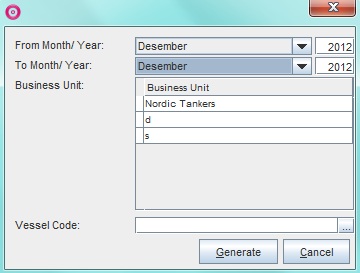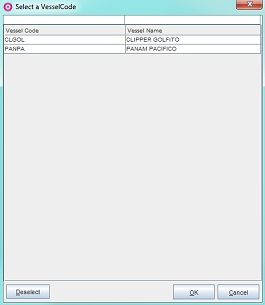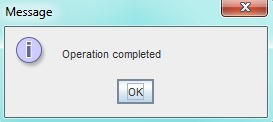Time Correction
Short Description
The Time Correction module enables a user to calculate periodic pro-rate voyage days (or proration) for a selected period per business unit/s. The Time Correction module is part of the Period-End-Closing process and must be run (to update/refresh data) prior to closing a period.
The records in the Time Correction module, once generated, will display the total number of days of a voyage/vessel that occurred during each month of a selected time period. It will also display the total number of each type (or category) of day a voyage has consisted of during each month of a selected time period. The categories are:
- Onhire Days
- Repair, Breakdown, Supply, Delay (RBSD) Days (Viewed as Offhire)
- Dry Dock Days (Viewed as Offhire)
- Ballast to Dry Dock Days (Viewed as Offhire)
- Idle Days (not Viewed as Offhire)
If a voyage begins prior to or runs longer than the prorated period, a breakdown of days/month for the time before/after the prorated period is also displayed. Example: A voyage lasts from mid-January to the end of May. Proration is generated for the month of March. The module will display a breakdown for the entire voyage/vessel/month because a part of it crosses the prorated month.
The amount of days of a voyage calculated in the module is used to calculate a portion of a voyage’s result during a particular period (month). Each time proration is generated for a period the number of days are updated/re-calculated. The days are estimates, as a voyage might still be in progress when proration is generated, but they found the basis for all other types of accounting estimation, i.e. Accruals, Internal Allocations, Bunker Stock Adjustments and Running and Overhead Costs. When verifying that proration has been executed correctly, ensure that the breakdown days of each row matches its total number of days and that the total number of days/month for a vessel matches the number of days/month.
The Time Correction module also contains the Freeze and Freeze and Transfer options. The Freeze option allows a user to prevent the re-calculation of a voyage’s days for a specific month when time correction is generated (for the next period). If the days of a specific month are frozen, its status will change from Not frozen to Frozen in the Status column and the days of the frozen period will remain unchanged when proration is re-generated. If the actual number of days differ from the estimate for this period come next period the difference in days (positive and negative) will show as part of that period, as the total number of voyage days must always match the total duration of the voyage.
The Freeze option is useful for, for example audits and accounting purposes, where it can be beneficial to keep the days as estimated figures, ev en if the actual number of days is established the following month or later. To simultaneously freeze a period in Dataloy VMS and send the frozen days to an accounting system select the Freeze and Transfer option. The Time Correction module can also handle overlapping voyages to ensure the correct number of days are calculated.
In the Time Correction module only offhire records marked as Deduct Against Owner are counted as offhire. All other days will fall under Idle Days.
Location: Modules > Accounting > Time Correction
Chapters:
Long Description
Run Time Correction (or Proration)
Go to
Modules > Accounting > Time Correction.The Time Correction window opens.
Note: Any previous proration data displays in the main panel of the module. If no previous proration have been run - the view will be empty.
Example:Click Run Time Correction... A dialog box opens.
Example:- Fill in the fields as follows:
- Select the month (from the drop-down menu) and the year to run time correction from under From Month/Year.
- Select the month (from the drop-down menu) and the year to run time correction to under To Month/Year.
- Click the applicable business unit/s under Business Unit.
- Enter either
- the vessel code to update proration data for a single vessel (if applicable) under Vessel Class
- or click the Triple Dot Selector next to the field. A pop-up with a list of input values opens. Select field and click OK.
Example:
- Click Generate. A pop-up opens requesting confirmation start time correction. The process may take a while.
- Click OK. The pop-up will close and the time correction process commence.
- Once the time correction is complete, a pop-up opens with advising this.
- Click OK. The pop-up will close and the updated/refreshed time correction (or proration) data for each voyage of the selected business unit/s for the specified period appear as rows.
Example:
8. Once proration is complete: to continue accounting period closing - return to the Period-End-Closing Process page.
Verify Time Correction (or Proration)
- Go to
Modules > Accounting > Time Correction.The Time Correction window opens. - Verification consists of two steps:
- Ensure that the breakdown days of each row matches its total number of days:
- Filter the updated proration list to display the records for the relevant period only.
- Click the magnifying glass icon at the top-right corner.
- A row displays above the columns.
- Type
- relevant year in the field above the Year column
- and relevant month in the field above the Month column.
Note: Enter month as m or mm, for example: if running for March, type either '03' or '3' to show only the records for this period.
Example:
- Press Enter.
- Review and verify the final resulting list of data, especially the Total Days column and the five columns detailing the breakdown of days: Onhire Days, RBSD Days (Repair, Breakdown, Supply, Delay), Dry Dock Days, Ballast to Dry Dock Days and Idle Days.
- Ensure that the total number of days/month for a vessel matches the number of days/month:
- Follow the step-by-step instructions of Steps 1-2v above.
- Once the period to be verified display, click the calculation icon at the top-right corner.
- At the bottom of the screen a status bar indicates the sums of each column. Check that the total number of days matches the number days of the prorated month.
Example:
Proration run form January 2012.
- Ensure that the breakdown days of each row matches its total number of days:
3. Once the verification is complete: to continue accounting period closing - return to the Period-End-Closing Process page.
Freeze or Freeze and Transfer a Voyage
- Go to
Modules > Accounting > Time Correction.The Time Correction window opens.
Note: Any previous proration data will be displayed in the main panel of the module. - Click Freeze and from the drop-down menu select either Freeze Only... or Freeze and Transfer.
Note: Freeze Only... will freeze selected prorated period/s in Dataloy VMS only. Freeze and Transfer will freeze selected prorated period/s in Dataloy VMS and transfer the frozen data to an accounting system.
Example: - A dialog box opens.
Example: - Fill in the fields as follows:
- Select the month (from the drop-down menu) and the year to run time correction from under From Month/Year.
- Select the month (from the drop-down menu) and the year to run time correction to under To Month/Year.
- Click the applicable business unit/s under Business Unit.
- Click Transfer. A pop-up opens requesting confirmation to freeze selected time correction data.
Example: - Click OK. The pop-up will close and another open advising the number of records now marked as frozen.
Example: - Click OK. The pop-up will close and another open advising that the operation has been completed.
- Click OK. The pop-up will close and the status for the newly frozen records change from Not frozen to Frozen under Status. If Freeze and Transfer was selected data regarding the frozen records is sent to relevant accounting system.
Example:


















